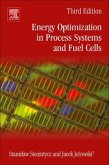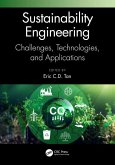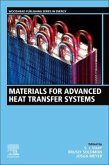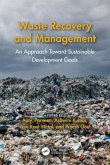Handbook of Process Integration (PI)
Minimisation of Energy and Water Use, Waste and Emissions
Herausgegeben:Klemes, Jirí Jaromír
Handbook of Process Integration (PI)
Minimisation of Energy and Water Use, Waste and Emissions
Herausgegeben:Klemes, Jirí Jaromír
- Broschiertes Buch
- Merkliste
- Auf die Merkliste
- Bewerten Bewerten
- Teilen
- Produkt teilen
- Produkterinnerung
- Produkterinnerung
Handbook of Process Integration (PI): Minimisation of Energy and Water Use, Waste and Emissions, Second Edition provides an up-to-date guide on the latest PI research and applications. Since the first edition published, methodologies and sustainability targets have developed considerably. Each chapter has been fully updated, with six new chapters added in this release, covering emissions, transport, water scarcity, reliability and maintenance, environmental impact and circular economy. This version also now includes worked examples and simulations to deepen the reader's understanding.
With…mehr
Andere Kunden interessierten sich auch für
![Sustainability in the Design, Synthesis and Analysis of Chemical Engineering Processes Sustainability in the Design, Synthesis and Analysis of Chemical Engineering Processes]() Gerardo Ruiz MercadoSustainability in the Design, Synthesis and Analysis of Chemical Engineering Processes101,99 €
Gerardo Ruiz MercadoSustainability in the Design, Synthesis and Analysis of Chemical Engineering Processes101,99 €![Energy Optimization in Process Systems and Fuel Cells Energy Optimization in Process Systems and Fuel Cells]() Stanislaw SieniutyczEnergy Optimization in Process Systems and Fuel Cells228,99 €
Stanislaw SieniutyczEnergy Optimization in Process Systems and Fuel Cells228,99 €![Sustainability Engineering Sustainability Engineering]() Sustainability Engineering149,99 €
Sustainability Engineering149,99 €![Net Zero Energy Buildings (NZEB) Net Zero Energy Buildings (NZEB)]() Shady AttiaNet Zero Energy Buildings (NZEB)100,99 €
Shady AttiaNet Zero Energy Buildings (NZEB)100,99 €![Materials for Advanced Heat Transfer Systems Materials for Advanced Heat Transfer Systems]() Materials for Advanced Heat Transfer Systems197,99 €
Materials for Advanced Heat Transfer Systems197,99 €![Waste Recovery and Management Waste Recovery and Management]() Waste Recovery and Management68,99 €
Waste Recovery and Management68,99 €![Clearchus of Soli Clearchus of Soli]() Clearchus of Soli58,99 €
Clearchus of Soli58,99 €-
-
-
Handbook of Process Integration (PI): Minimisation of Energy and Water Use, Waste and Emissions, Second Edition provides an up-to-date guide on the latest PI research and applications. Since the first edition published, methodologies and sustainability targets have developed considerably. Each chapter has been fully updated, with six new chapters added in this release, covering emissions, transport, water scarcity, reliability and maintenance, environmental impact and circular economy. This version also now includes worked examples and simulations to deepen the reader's understanding.
With its distinguished editor and international team of expert contributors, this book is an important reference work for managers and researchers in all energy and sustainability industries, as well as academics and students in Energy, Chemical, Process, and Environmental Engineering.
With its distinguished editor and international team of expert contributors, this book is an important reference work for managers and researchers in all energy and sustainability industries, as well as academics and students in Energy, Chemical, Process, and Environmental Engineering.
Produktdetails
- Produktdetails
- Woodhead Publishing Series in Energy
- Verlag: Elsevier Science & Technology / Woodhead Publishing
- Artikelnr. des Verlages: C2020-0-01220-X
- 2. Aufl.
- Englisch
- Abmessung: 54mm x 152mm x 229mm
- Gewicht: 1889g
- ISBN-13: 9780128238509
- Artikelnr.: 61695148
- Herstellerkennzeichnung Die Herstellerinformationen sind derzeit nicht verfügbar.
- Woodhead Publishing Series in Energy
- Verlag: Elsevier Science & Technology / Woodhead Publishing
- Artikelnr. des Verlages: C2020-0-01220-X
- 2. Aufl.
- Englisch
- Abmessung: 54mm x 152mm x 229mm
- Gewicht: 1889g
- ISBN-13: 9780128238509
- Artikelnr.: 61695148
- Herstellerkennzeichnung Die Herstellerinformationen sind derzeit nicht verfügbar.
Part I: Overview of Process Integration and Analysis
1. Process Integration (PI): An Introduction
2. Basic Process Integration Terminology
3. Process Design, Integration and Optimisation: Advantages, Challenges and Drivers
Part II: Heat Integration
4. Heat Integration: Targets and Heat Exchanger Network Design
5. Application of Process Integration to the Synthesis of Heat and Power Utility Systems Including Combined Heat and Power (CHP) and Industrial Heat Pumps
6. Total Site Methodology
7. Extending Total Site Methodology to Address Varying Energy Supply and Demand
8. Analysis and Design of Heat Recovery Systems for Grassroots and Retrofit Situations
9. Heat Integration in Batch Processes
Part III: Mass Integration
10. Water Pinch Analysis for Water Management and Minimisation: An Introduction
11. Using Systematic Design Methods to Minimise Water Use in Process Industries
12. Synthesis of Water Networks with Water Loss and Gain via an Extended Pinch Analysis Technique
13. Conserving Material Resources through Process Integration: Material Conservation Networks
Part IV: Extended Process Integration
14. Process Integration for Cleaner Process Design
15. Process Integration Concepts for Combined Energy and Water Integration
16. Process Integration Techniques for Cogeneration and Trigeneration Systems
17. Pinch Analysis for Sustainable Energy Planning Using Diverse Quality Measures
18. A Unified Targeting Algorithm for Diverse Process Integration Problems
19. A Process Integration Approach for Supply Chain Development
20. Application of Heat Recovery Loops to Semi-continuous Processes for Process Integration
Part V: Applications and Case Studies
21. Applications of Energy and Water Process Integration Methodologies in Oil Refineries and Petrochemical Complexes
22. Process Integration of an Oil Refinery Hydrogen Network
23. Retrofit Mass Integration of Acid Gas Removal Systems in Petrochemical Plants
24. Applications of Pinch Technology to Total Sites: A Heavy Chemical Industrial Complex and a Steel Plant
25. Applications of Process Integration Methodologies in the Pulp and Paper Industry
26. Application of Process Integration Methodologies to the Thermal Processing of Waste
27. Application of Process Integration Methodologies in the Brewing Industry
28. Applications of Process Integration Methodologies in Dairy and Cheese Production
29. Applications of Process Integration Methodologies in Beet Sugar Plants
30. Application of Process Integration Techniques for the Efficient Use of Energy in a Urea Fertiliser Plant:
31. Process Integration for Energy Saving in Buildings and Building Complexes
32. Heat Transfer Enhancement in Heat Exchanger Networks
33. Applications of Pinch Analysis in the Design of Isolated Energy Systems
Part VI: Software Tools and Epilogue
34. Software Tools for Heat Integration
35. Mass and Water Integration Software Tools
36. Epilogue: The Importance of Problem Formulation and Data Extraction in Process Integration
1. Process Integration (PI): An Introduction
2. Basic Process Integration Terminology
3. Process Design, Integration and Optimisation: Advantages, Challenges and Drivers
Part II: Heat Integration
4. Heat Integration: Targets and Heat Exchanger Network Design
5. Application of Process Integration to the Synthesis of Heat and Power Utility Systems Including Combined Heat and Power (CHP) and Industrial Heat Pumps
6. Total Site Methodology
7. Extending Total Site Methodology to Address Varying Energy Supply and Demand
8. Analysis and Design of Heat Recovery Systems for Grassroots and Retrofit Situations
9. Heat Integration in Batch Processes
Part III: Mass Integration
10. Water Pinch Analysis for Water Management and Minimisation: An Introduction
11. Using Systematic Design Methods to Minimise Water Use in Process Industries
12. Synthesis of Water Networks with Water Loss and Gain via an Extended Pinch Analysis Technique
13. Conserving Material Resources through Process Integration: Material Conservation Networks
Part IV: Extended Process Integration
14. Process Integration for Cleaner Process Design
15. Process Integration Concepts for Combined Energy and Water Integration
16. Process Integration Techniques for Cogeneration and Trigeneration Systems
17. Pinch Analysis for Sustainable Energy Planning Using Diverse Quality Measures
18. A Unified Targeting Algorithm for Diverse Process Integration Problems
19. A Process Integration Approach for Supply Chain Development
20. Application of Heat Recovery Loops to Semi-continuous Processes for Process Integration
Part V: Applications and Case Studies
21. Applications of Energy and Water Process Integration Methodologies in Oil Refineries and Petrochemical Complexes
22. Process Integration of an Oil Refinery Hydrogen Network
23. Retrofit Mass Integration of Acid Gas Removal Systems in Petrochemical Plants
24. Applications of Pinch Technology to Total Sites: A Heavy Chemical Industrial Complex and a Steel Plant
25. Applications of Process Integration Methodologies in the Pulp and Paper Industry
26. Application of Process Integration Methodologies to the Thermal Processing of Waste
27. Application of Process Integration Methodologies in the Brewing Industry
28. Applications of Process Integration Methodologies in Dairy and Cheese Production
29. Applications of Process Integration Methodologies in Beet Sugar Plants
30. Application of Process Integration Techniques for the Efficient Use of Energy in a Urea Fertiliser Plant:
31. Process Integration for Energy Saving in Buildings and Building Complexes
32. Heat Transfer Enhancement in Heat Exchanger Networks
33. Applications of Pinch Analysis in the Design of Isolated Energy Systems
Part VI: Software Tools and Epilogue
34. Software Tools for Heat Integration
35. Mass and Water Integration Software Tools
36. Epilogue: The Importance of Problem Formulation and Data Extraction in Process Integration
Part I: Overview of Process Integration and Analysis
1. Process Integration (PI): An Introduction
2. Basic Process Integration Terminology
3. Process Design, Integration and Optimisation: Advantages, Challenges and Drivers
Part II: Heat Integration
4. Heat Integration: Targets and Heat Exchanger Network Design
5. Application of Process Integration to the Synthesis of Heat and Power Utility Systems Including Combined Heat and Power (CHP) and Industrial Heat Pumps
6. Total Site Methodology
7. Extending Total Site Methodology to Address Varying Energy Supply and Demand
8. Analysis and Design of Heat Recovery Systems for Grassroots and Retrofit Situations
9. Heat Integration in Batch Processes
Part III: Mass Integration
10. Water Pinch Analysis for Water Management and Minimisation: An Introduction
11. Using Systematic Design Methods to Minimise Water Use in Process Industries
12. Synthesis of Water Networks with Water Loss and Gain via an Extended Pinch Analysis Technique
13. Conserving Material Resources through Process Integration: Material Conservation Networks
Part IV: Extended Process Integration
14. Process Integration for Cleaner Process Design
15. Process Integration Concepts for Combined Energy and Water Integration
16. Process Integration Techniques for Cogeneration and Trigeneration Systems
17. Pinch Analysis for Sustainable Energy Planning Using Diverse Quality Measures
18. A Unified Targeting Algorithm for Diverse Process Integration Problems
19. A Process Integration Approach for Supply Chain Development
20. Application of Heat Recovery Loops to Semi-continuous Processes for Process Integration
Part V: Applications and Case Studies
21. Applications of Energy and Water Process Integration Methodologies in Oil Refineries and Petrochemical Complexes
22. Process Integration of an Oil Refinery Hydrogen Network
23. Retrofit Mass Integration of Acid Gas Removal Systems in Petrochemical Plants
24. Applications of Pinch Technology to Total Sites: A Heavy Chemical Industrial Complex and a Steel Plant
25. Applications of Process Integration Methodologies in the Pulp and Paper Industry
26. Application of Process Integration Methodologies to the Thermal Processing of Waste
27. Application of Process Integration Methodologies in the Brewing Industry
28. Applications of Process Integration Methodologies in Dairy and Cheese Production
29. Applications of Process Integration Methodologies in Beet Sugar Plants
30. Application of Process Integration Techniques for the Efficient Use of Energy in a Urea Fertiliser Plant:
31. Process Integration for Energy Saving in Buildings and Building Complexes
32. Heat Transfer Enhancement in Heat Exchanger Networks
33. Applications of Pinch Analysis in the Design of Isolated Energy Systems
Part VI: Software Tools and Epilogue
34. Software Tools for Heat Integration
35. Mass and Water Integration Software Tools
36. Epilogue: The Importance of Problem Formulation and Data Extraction in Process Integration
1. Process Integration (PI): An Introduction
2. Basic Process Integration Terminology
3. Process Design, Integration and Optimisation: Advantages, Challenges and Drivers
Part II: Heat Integration
4. Heat Integration: Targets and Heat Exchanger Network Design
5. Application of Process Integration to the Synthesis of Heat and Power Utility Systems Including Combined Heat and Power (CHP) and Industrial Heat Pumps
6. Total Site Methodology
7. Extending Total Site Methodology to Address Varying Energy Supply and Demand
8. Analysis and Design of Heat Recovery Systems for Grassroots and Retrofit Situations
9. Heat Integration in Batch Processes
Part III: Mass Integration
10. Water Pinch Analysis for Water Management and Minimisation: An Introduction
11. Using Systematic Design Methods to Minimise Water Use in Process Industries
12. Synthesis of Water Networks with Water Loss and Gain via an Extended Pinch Analysis Technique
13. Conserving Material Resources through Process Integration: Material Conservation Networks
Part IV: Extended Process Integration
14. Process Integration for Cleaner Process Design
15. Process Integration Concepts for Combined Energy and Water Integration
16. Process Integration Techniques for Cogeneration and Trigeneration Systems
17. Pinch Analysis for Sustainable Energy Planning Using Diverse Quality Measures
18. A Unified Targeting Algorithm for Diverse Process Integration Problems
19. A Process Integration Approach for Supply Chain Development
20. Application of Heat Recovery Loops to Semi-continuous Processes for Process Integration
Part V: Applications and Case Studies
21. Applications of Energy and Water Process Integration Methodologies in Oil Refineries and Petrochemical Complexes
22. Process Integration of an Oil Refinery Hydrogen Network
23. Retrofit Mass Integration of Acid Gas Removal Systems in Petrochemical Plants
24. Applications of Pinch Technology to Total Sites: A Heavy Chemical Industrial Complex and a Steel Plant
25. Applications of Process Integration Methodologies in the Pulp and Paper Industry
26. Application of Process Integration Methodologies to the Thermal Processing of Waste
27. Application of Process Integration Methodologies in the Brewing Industry
28. Applications of Process Integration Methodologies in Dairy and Cheese Production
29. Applications of Process Integration Methodologies in Beet Sugar Plants
30. Application of Process Integration Techniques for the Efficient Use of Energy in a Urea Fertiliser Plant:
31. Process Integration for Energy Saving in Buildings and Building Complexes
32. Heat Transfer Enhancement in Heat Exchanger Networks
33. Applications of Pinch Analysis in the Design of Isolated Energy Systems
Part VI: Software Tools and Epilogue
34. Software Tools for Heat Integration
35. Mass and Water Integration Software Tools
36. Epilogue: The Importance of Problem Formulation and Data Extraction in Process Integration



